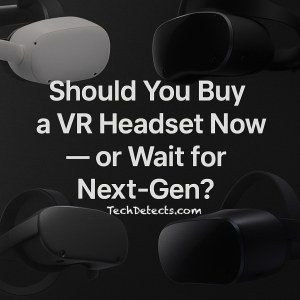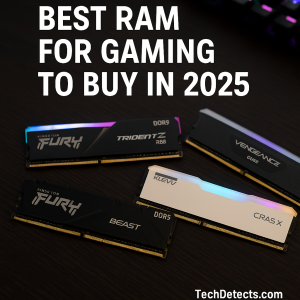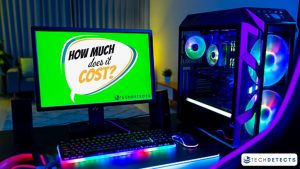Should You Buy a VR Headset in August 2025—or Wait for Next-Gen?
You’re eyeing a VR headset, but the tech landscape is shifting fast. With major upgrades rumored and emerging lightweight alternatives on the horizon, buyers now weigh: is it better to buy now or wait?

Should You Buy a VR Headset Now?
Currently Available VR Headsets (2025)
Apple Vision Pro
- Price: Starting at $3,499
- Key Specs: Dual micro‑OLED displays (~3660×3200 px/eye), Apple M2 chip with R1 co-processor, 16GB RAM, eye tracking, spatial audio, hand/gesture tracking, external battery (~2–2.5 hours)
- Strengths: Best-in-class spatial computing, stunning display, Apple ecosystem integration, productivity and entertainment ready
- Drawbacks: Expensive, heavy, some discomfort in prolonged use, app library still maturing
- Ideal For: Professionals, early adopters, Apple ecosystem users wanting cutting-edge MR
👉 Buy on Official Apple Website
Meta Quest 3
- Price: Starting at $499
- Key Specs: Snapdragon XR2 Gen 2, pancake lenses, mixed reality passthrough, 120Hz refresh, inside-out tracking, hand tracking 2.0
- Strengths: Excellent standalone experience, top-tier app library, robust developer support
- Drawbacks: Bulky compared to what’s coming, not ideal for long wear sessions
- Ideal For: General VR users who want the best standalone experience available now
Meta Quest 3S
- Price: $299 (128GB), $359 (256GB)
- Key Specs: Similar to Quest 3 but with LCD panel, lower resolution, and fewer RAM
- Strengths: Great budget option, full access to Quest ecosystem
- Drawbacks: Slight dip in visual fidelity compared to Quest 3
- Ideal For: Newcomers, casual gamers, budget-conscious buyers
PlayStation VR2 (PSVR2)
- Price: $369.95 (often bundled with games)
- Key Specs: OLED display, eye tracking, 4K HDR, haptic feedback, adaptive triggers
- Strengths: Premium visuals, great for PlayStation users, immersive haptics
- Drawbacks: Requires PS5, limited standalone capabilities
- Ideal For: Console gamers wanting a polished VR experience
Pico 4 Ultra (UK & select markets)
- Price: Approx. £439
- Key Specs: Snapdragon XR2 Gen 2, 12GB RAM, pancake lenses, 4K+ resolution
- Strengths: Light build, high resolution, growing app base
- Drawbacks: Not widely available, ecosystem smaller than Meta’s
- Ideal For: Europe-based users seeking an alternative to Meta
HTC Vive XR Elite
- Price: $899.99
- Key Specs: Standalone and PC VR hybrid, high-resolution display, eye tracking
- Strengths: Versatile use, modular design, productivity-ready
- Drawbacks: Pricey, not as user-friendly for beginners
- Ideal For: VR pros, developers, business use
Samsung Galaxy XR (2025 Flagship Android XR Headset)
- Price: Starting around $1,099
- Key Specs: Snapdragon XR2+ Gen 2 processor, dual OLED displays (~3200×3200 per eye), One UI XR software, inside-out tracking, hand and eye tracking, Wi-Fi 7 connectivity
- Strengths: First Android XR device co-developed by Samsung, Google, and Qualcomm. Brings premium OLED visuals and smooth mixed-reality integration to the Android ecosystem.
- Drawbacks: New platform means a smaller app library than Meta Quest or Apple Vision Pro (for now).
- Ideal For: Users who want high-end mixed reality with Android integration — from media and productivity to casual gaming and streaming.
👉 Buy on Official Samsung Website
Pimax Crystal Super / Dream Air
- Price: $1,700+
- Key Specs: Ultra-high resolution, eye tracking, foveated rendering
- Strengths: Top-end fidelity, sim racing and flight sim favorite
- Drawbacks: Expensive, setup complexity, niche use case
- Ideal For: Enthusiasts, simulation fans
What’s Coming: Rumored Headsets & Release Windows
With Galaxy XR now officially launched in late 2025, the next wave of devices will build upon Android XR as a common platform — setting the stage for AI-driven spatial apps and lighter hardware in 2026.
Apple Vision Pro 2
- Launch Window: Late 2025
- Expected Upgrades: M4 or M5 chip, enhanced AI features, ergonomic improvements, possibly lighter build
- Why It Matters: Brings Apple’s polish to spatial computing, new neural engine capabilities
Meta “Puffin” (lightweight MR goggles)
- Launch Window: Late 2026
- Highlights: ~110g form factor, tethered to compute puck, MR-focused
- Why It Matters: Could redefine daily-wear mixed reality gear; prioritizes comfort and portability
Meta “Loma” content-first device
- Launch Window: 2026
- Partnerships: Disney, A24, exclusive storytelling content
- Why It Matters: Blends premium hardware with studio-grade content in MR format
ASUS Tarius MR Headset
- Launch Window: Mid-to-late 2026
- Rumored Features: Eye and face tracking, OLED/QD-LCD panels, productivity tilt
- Why It Matters: ASUS enters MR space with possible enterprise focus
Who Should Buy Now?
- Apple users seeking spatial productivity: Vision Pro is available now and delivers unmatched mixed-reality experiences for productivity, content creation, and premium media.
- Gamers seeking value: Meta Quest 3S at $299 delivers unbeatable performance for its price. The Quest 3 is great for those who want future-ready MR with a deep app ecosystem.
- Console owners: PSVR2 is a no-brainer if you already own a PS5. It provides a high-end VR experience at a very competitive price.
- Android enthusiasts and mixed-reality explorers: Galaxy XR delivers premium optics and tight ecosystem integration without the heft or price of Vision Pro. If you own a Galaxy phone or tablet, it’s the most seamless XR option today.
- Newcomers to VR: If this is your first headset and you don’t want to wait, current-gen models like Quest 3 and 3S are well-supported and offer great content.
- PC VR enthusiasts: HTC Vive XR Elite or Pimax models provide exceptional visual fidelity and customization for advanced users.
Highly recommended to check it out: Top VR Headsets for Gaming in 2025 (PC, Console & Standalone)
Who Should Wait?
- Portability-focused users: Meta’s upcoming “Puffin” headset aims to dramatically reduce the bulk of VR hardware, making it easier for extended or everyday use.
- Apple ecosystem fans: If you’re deeply embedded in Apple’s ecosystem or intrigued by spatial computing but turned off by the Vision Pro’s size or price, Vision Pro 2 might be worth holding out for.
- Storytelling and immersive content lovers: Meta’s “Loma” project aims to merge premium MR hardware with high-end narrative experiences, potentially launching a new entertainment category.
- Enterprise or productivity users: ASUS’s Tarius and Apple’s Vision Pro 2 both target professional-grade features and workflows, likely offering better tools for work-focused buyers.
Final Take
If you’re curious about VR and want to jump in today, there’s no need to hesitate—current devices offer mature ecosystems, great hardware, and accessible prices. But if your priority is cutting-edge comfort, professional features, or brand-specific ecosystems, holding off until late 2025 or 2026 may be worth the wait.
Update (Late 2025): Samsung’s Galaxy XR launch has reshaped the buy-now equation. It arrives as the first Android XR flagship with OLED displays and spatial computing features at a mid-premium price, offering a realistic third path between Meta and Apple. For many users, the future of XR is no longer something to wait for — it’s here and wearable today.






